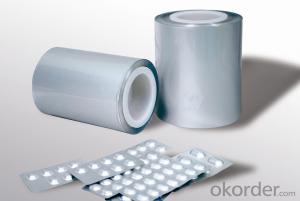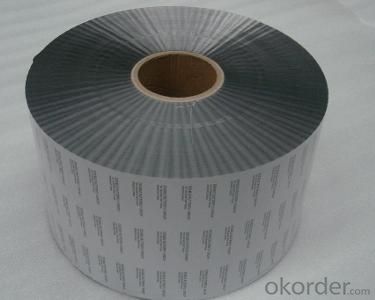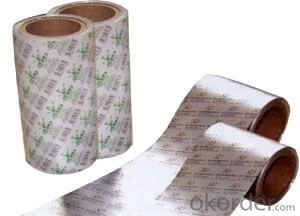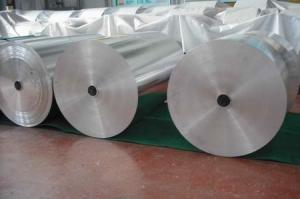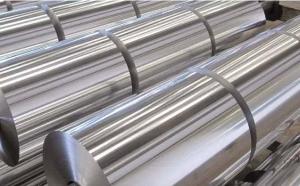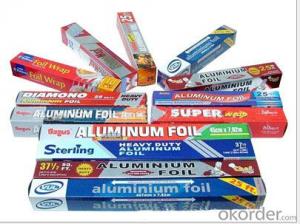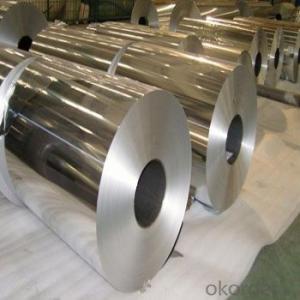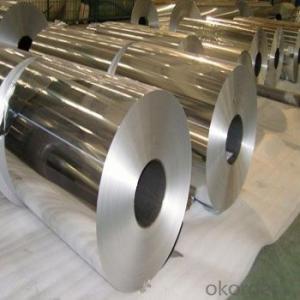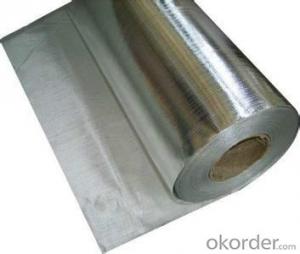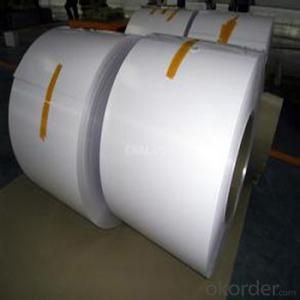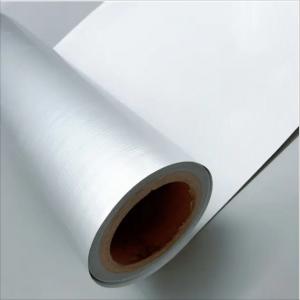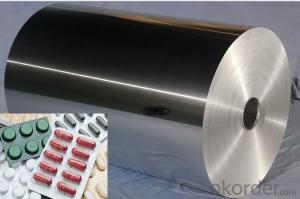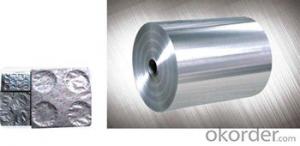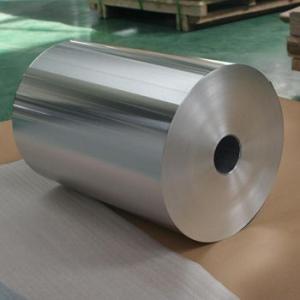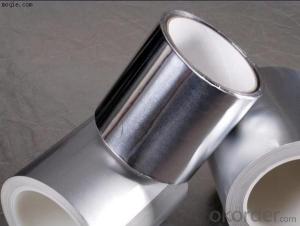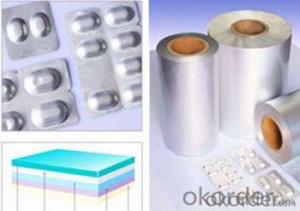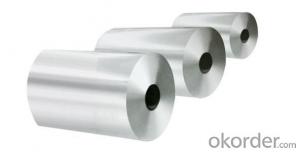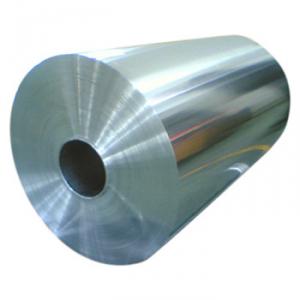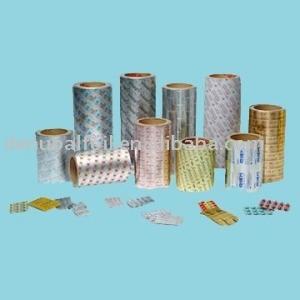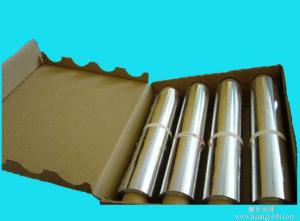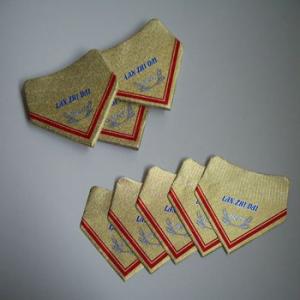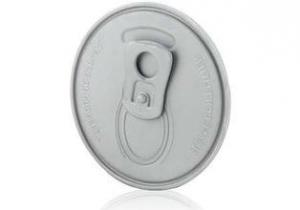Aluminum Foil 200 Ft for Pharmaceutical Use
- Loading Port:
- China Main Port
- Payment Terms:
- TT OR LC
- Min Order Qty:
- -
- Supply Capability:
- -
OKorder Service Pledge
OKorder Financial Service
You Might Also Like
Aluminium foil acts as a total barrier to light and oxygen (which cause fats to oxidise or become rancid), odours and flavours, moistness, and germs, it is used broadly in food and pharmaceutical packaging. The purpose of aluminium is to make long-life packs (aseptic processing|aseptic packaging) for drinks and dairy goods, which allows storing without refrigeration. Aluminium foil containers and trays are used to bake pies and to pack takeaway meals, ready snacks and long life pet foods.
Aluminium foil is widely sold into the consumer market, often in rolls of 500 mm (20 in) width and several metres in length.It is used for wrapping food in order to preserve it, for example, when storing leftover food in a refrigerator (where it serves the additional purpose of preventing odour exchange), when taking sandwiches on a journey, or when selling some kinds of take-away or fast food. Tex-Mex restaurants in the United States, for example, typically provide take-away burritos wrapped in aluminium foil.
Aluminium foils thicker than 25 μm (1 mil) are impermeable to oxygen and water. Foils thinner than this become slightly permeable due to minute pinholes caused by the production process.
Aluminium foil has a shiny side and a matte side. The shiny side is produced when the aluminium is rolled during the final pass. It is difficult to produce rollers with a gap fine enough to cope with the foil gauge, therefore, for the final pass, two sheets are rolled at the same time, doubling the thickness of the gauge at entry to the rollers. When the sheets are later separated, the inside surface is dull, and the outside surface is shiny. This difference in the finish has led to the perception that favouring a side has an effect when cooking. While many believe that the different properties keep heat out when wrapped with the shiny finish facing out, and keep heat in with the shiny finish facing inwards, the actual difference is imperceptible without instrumentation.The reflectivity of bright aluminium foil is 88% while dull embossed foil is about 80%.
We provide a full range of precision aluminum strip for almost any application. We produce aluminum strip in a wide variety of alloys, including clad composites. Our aluminum strip can be produced in standard dimensions or custom made to your special requirements. We produce both imperial and metric units. We manufacture in compliance with the main international specifications, and tighter tolerances or custom tempers are available upon request. We offer various surface conditions, custom finishes (painting, anodizing, embossing), special processing, and multiple packaging options to meet our customer's unique requirements. The following is a summary of our capabilities.
Manufactured in compliance with the main international specifications and standards, including: Aluminum Association, ASTM, EN, and DIN.
We can also manufacture in compliance with other international standards including:ASME, SAE, AMS, AWS, FED, MIL, QQ, ISO, BS, AFNOR, JIS and GOST.
Manufactured in compliance with the main international specifications and standards.
Tighter tolerances are available upon request.
Aluminium (or aluminum; see spelling differences) is a chemical element in the boron group with symbol Al and atomic number 13. It is a silvery white, soft, ductile metal. Aluminium is the third most abundant element (after oxygen and silicon), and the most abundant metal in the Earth's crust. It makes up about 8% by weight of the Earth's solid surface. Aluminium metal is so chemically reactive that native specimens are rare and limited to extreme reducing environments. Instead, it is found combined in over 270 different minerals.The chief ore of aluminium is bauxite.
Aluminium is remarkable for the metal's low density and for its ability to resist corrosion due to the phenomenon of passivation. Structural components made from aluminium and its alloys are vital to the aerospace industry and are important in other areas of transportation and structural materials. The most useful compounds of aluminium, at least on a weight basis, are the oxides and sulfates.
Despite its prevalence in the environment, no known form of life uses aluminium salts metabolically. In keeping with its pervasiveness, aluminium is well tolerated by plants and animals. Owing to their prevalence, potential beneficial (or otherwise) biological roles of aluminium compounds are of continuing interest.
The earliest citation given in the Oxford English Dictionary for any word used as a name for this element is alumium, which British chemist and inventor Humphry Davy employed in 1808 for the metal he was trying to isolate electrolytically from the mineral alumina. The citation is from the journal Philosophical Transactions of the Royal Society of London: "Had I been so fortunate as to have obtained more certain evidences on this subject, and to have procured the metallic substances I was in search of, I should have proposed for them the names of silicium, alumium, zirconium, and glucium."
Davy settled on aluminum by the time he published his 1812 book Chemical Philosophy: "This substance appears to contain a peculiar metal, but as yet Aluminum has not been obtained in a perfectly free state, though alloys of it with other metalline substances have been procured sufficiently distinct to indicate the probable nature of alumina."[69] But the same year, an anonymous contributor to the Quarterly Review, a British political-literary journal, in a review of Davy's book, objected to aluminum and proposed the name aluminium, "for so we shall take the liberty of writing the word, in preference to aluminum, which has a less classical sound."
The -ium suffix conformed to the precedent set in other newly discovered elements of the time: potassium, sodium, magnesium, calcium, and strontium (all of which Davy isolated himself). Nevertheless, -um spellings for elements were not unknown at the time, as for example platinum, known to Europeans since the 16th century, molybdenum, discovered in 1778, and tantalum, discovered in 1802. The -um suffix is consistent with the universal spelling alumina for the oxide (as opposed to aluminia), as lanthana is the oxide of lanthanum, and magnesia, ceria, and thoria are the oxides of magnesium, cerium, and thorium respectively.
The aluminum spelling is used in the Webster's Dictionary of 1828. In his advertising handbill for his new electrolytic method of producing the metal in 1892, Charles Martin Hall used the -um spelling, despite his constant use of the -ium spelling in all the patents[58] he filed between 1886 and 1903. It has consequently been suggested[by whom?] that the spelling reflects an easier-to-pronounce word with one fewer syllable, or that the spelling on the flyer was a mistake.[citation needed] Hall's domination of production of the metal ensured that aluminum became the standard English spelling in North America.
- Q: I know that C has a -2 charge and Al has a +3 Charge, my answer came out to be AlC6 because I multiplied the charges togetherWould somebody be able to show me the steps to finding the correct formula please???
- elements are the simple pure form of a thinglike Zinc is only zinc (nothing else - so it is a elementCompounds are elements(plural) joined together exactly -( like water Hydrogen in direct proportion to the amount of oxygen hence it always stays the same , no matter what you do to it) A mixture is lots of things ( no proportions - just mixed up ) im no good at chem either but this is quite a basic starting point.
- Q: I am getting married in June and I am making choc bride and groomsI was wondering if I could make them now and freeze them or put them in a air tight container or if there is different way that Icould keep them until June 23 ? I am getting very bored and running out of things to keep me busyThanks
- To keep chocolate fresh and flavorful, store Chocolate in a cool, dry place, at approximately 60-65 degrees FahrenheitTo prevent chocolate from absorbing unwanted flavors and odors, wrap in aluminum foil and then place in plastic or an airtight containerWhen not stored correctly chocolate will bloomBlooming occurs when the cocoa butter crystallizes and rises to the surface creating a white coating on the chocolateAlthough blooming ruins the appearance of the chocolate it does not affect the tasteIf you are planning on freezing chocolate, be sure to wrap in aluminum foil, plastic, and store in airtight container before placing in the freezerTo use frozen chocolate, thaw in the refrigerator without removing from the container to prevent condensation from forming on the chocolateOnce thawed, remove the chocolate from the refrigerator and allow chocolate to come to room temperature before servingAlthough freezing is a convenient way to store chocolate for extended periods, nothing tastes better then fresh.
- Q: I am having some mahi mahi shipped from a fish market, and plan to do either risotto or garlic mashed potatoes, some asparagus with a balsamic butter, and a flour less chocolate cake with whipped cream and strawberriesI am not sure how to prepare the mahi mahiI want it to be elegant.
- When I store stuff in freezer, I put on plastic then put on Aluminum foilIf I just did aluminum it would disintegrate over timeThe plastic keeps the food from the foilThe best way I find is to try it and see what happens.
- Q: I had an aluminum slug that I measured the mass of as 8.669gThe length was 2.8cmThe radius was .950 cmThe volume (using a volumetric cylinder) was 3.5cm^3^We are supposed to do a calculated volume using (pir^2^h) also.but when I do it with the formula, it doesn't come out the same both waysI think I'm following everything, but it's just not coming close to being equalAm I doing something wrong, or did we (more than likely) not measure something right?
- SureAppliances like AC units, like refrigerators, work off a thermostat which turns them on and off as neededThey are designed to be left running on their own foreverIt does not make sense that a manufacturer would design and sell a unit which would fail in short order if left ON overnight.
- Q: Will aluminum foil work?Please give some good insulators of cold.
- Yes,aluminum foilAlso, styrofoam, Sawdust, wood, plastic, ceramics, rubber, shredded paper or put it in a vacuum.
- Q: Mtx Package - Your Opinion?
- ask the pharmacist he'll know
- Q: I want to do a mosaic (broken china) table top, any help on how to grout and how to trim table round edge?
- If I were doing this, I would tackle it one of two ways: either place the broken china pieces right on the edge, or, create a rim using a long strip of aluminim (or some other stiff but bendable material) and wrap this around the edge of the table being careful to keep it levelThen, use quickset to place the mozaic pieces where you want themOnce you have completely covered the table (and the pieces have had a chance to set), mix your grout a little on the runny side (not too much though), and splotch it in the middle of the tableUse a squeegy to make sure the grout fills in all the cracksDon't be afraid to go over the edge a bit to make sure of total fillageAfter this has set a bit, use a damp cloth or sponge to wipe off the excess on top of the china piecesWhen the quickset and grout have set, remove the aluminum stripYou can use 150 grit sandpaper (or coarser) to smooth out any rough spotsYou may want to consider a grout sealer to protect the table from spills, etcGood Luck~
- Q: I'm building a model roller coaster for physics.and I got all the materials down except the supportsanyone know any good materials to use for the supports? and the tracks are going to be plastic tubing thing
- Montreal Low Income Housing
- Q: I am a female..and although I'm all for girl power I need a light bike for easy transport. I plan on using it for leisurely cruises and occasional hiking/bike trails. What type of bike should I invest in- the most I'd like to spend is 250- steel or aluminum?
- Go to a local bike shop, tell him you want a hybrid, and you got $250 to spend. They might make you a special deal on one. A hybrid is a cross between a mountain bike and a road bike. Great for leisurely cruising and light off road. If you have no luck with the LBS, go to a box store and try to find a Schwinn hybrid in the right size. They are good bikes for the money. If they won't let you ride it around before you buy it, make sure there'll be no problem with returning it if it doesn't work for you, and that they've got somebody to make minor initial adjustments after you've ridden it a day or two. Later, the LBS will be glad to fix 'bout anything that'll go wrong with it. While you're at it, buy a floor pump to keep at home for airing the tires. Sizing is VERY important. Be careful about that.
- Q: am cooking cheese and onion pies for all the family to take home and dont want them to have my plates
- Somebody else asked a question like this for VA Beach, and I told her that her best bet to get a doctor who isn't going to push vaccinations is to go to a holistic doctor, if that's your kind of thingOtherwise, it's pretty much a shoot and miss/score situation until you find a doctor who you and your son are comfortable with.
Send your message to us
Aluminum Foil 200 Ft for Pharmaceutical Use
- Loading Port:
- China Main Port
- Payment Terms:
- TT OR LC
- Min Order Qty:
- -
- Supply Capability:
- -
OKorder Service Pledge
OKorder Financial Service
Similar products
Hot products
Hot Searches
Related keywords
